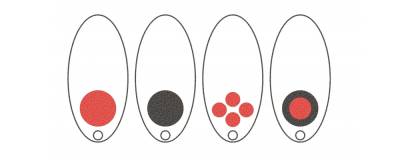Design of signalling
color patterns in fast-moving objects, including blades of spinning lures, must
be grounded upon the following 4 basic rules:
1) stimuli
must be bilaterally symmetric
2) color
stimuli must be located closer to the center of rotation
3) red colors are rather than blue ones
4) stimuli
must be simple
For more
information, see On the coloration of fast-moving
signalling stimili in the nature
In the
water, blades of spinning lures form clearly visible conical bodies of rotation
with an angle of rotation, depending on spinner construction and velocity of
retrieving, from 30o to 60o. The linear velocity of any
spot located at R distance from the axis of rotation is v = 2πR/T, where T is
an interim of one turn. If, say, the blade makes one turn per second and R =
0,5 cm, the linear velocity of this spot will be about 3 cm/sec. Generally, blades
of spinning lures may make several turns per second, and rotation radii of
spots may achieve 2-3 cm for lures of middle size. It means (for general principles, see Stojcev et al., 2011) that fish will see as flashing and colored only
those spots, which are located as close as possible to the axis of rotation (with
the lowest v).
For example, click here to see how Mepps spinners move (at the constant velocity) in the water.
According
to the laboratory experiments (Gehres & Neumeyer, 2007; Stojcev et al.,
2011), fish (goldfish, Carassius auratus) see fast-moving (7 cm per second) red and blue discs as colorless.
Figure
given bellow shows some color pattrens desined on the ground of the foregoing rules.

These
patterns can be used for face (convex) and back (concave) surfaces of the
blades.
Curently,
we are looking for world manufacturers to produce spinning lures with the
foregoing and similar color patterns.
All rights
reserved, © 2012
Address to Dr. Nick Yurchenko at fishermenadvocates@gmail.com
Basic References
Gehres M.M.,
Neumeyer C. 2007. Small
field motion detection in goldfish is red-green color blind and mediated by the
M-cone type. Visual Neuroscience 24,
399-407
Stojcev M.,
Radtke N., D'Amaro D., Dyer A.G., Neumeyer C. 2011. General principles in
motion vision: Color blindness of object motion
depends on pattern velocity in honeybee and goldfish. Visual Neuroscience 28, 361-370




